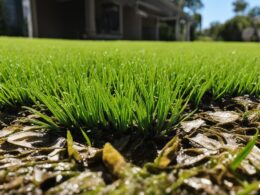If you’ve ever come across a lush green fern, you may have wondered about its unique characteristics. One intriguing aspect of ferns is their vascular tissue, which sets them apart from other plants. Vascular tissue plays a crucial role in the growth and survival of ferns, allowing them to thrive in diverse environments.
Ferns are fascinating seedless plants that have been around for millions of years, predating the existence of flowers and seeds. They possess two types of vascular tissue: xylem and phloem. Xylem is responsible for transporting water and nutrients from the roots to the rest of the plant, while phloem moves glucose and other organic compounds throughout the fern.
Fern leaves, known as fronds, contain intricate vascular strands that enable efficient water and nutrient distribution. This internal vascular system within the fronds helps ferns absorb moisture from the environment and distribute it to the entire plant.
But vascular tissue isn’t the only remarkable aspect of ferns. They also possess true roots, stems, and leaves, making them structurally similar to many other types of plants. Fern leaves begin as tightly coiled fiddleheads and unfurl into expansive fronds that can vary in shape, size, and intricacy.
Another unique feature of ferns is their underground stem called a rhizome. The rhizome acts as a storage organ for nutrients and water, as well as a source for new growth. It also gives rise to roots and aerial shoots, contributing to the overall growth and development of the fern plant.
Ferns have a complex life cycle that involves an alternation of generations. The recognizable fern plant we see is the sporophyte generation, while the gametophyte generation produces gametes for sexual reproduction. Ferns reproduce through spores, which are released from sporangia found on the underside of the fronds. These spores give rise to gametophytes, which produce both sperm and eggs. When fertilization occurs, a zygote is formed, ultimately developing into a new sporophyte fern plant.
Next, we’ll delve into the evolutionary advantages of vascular tissue in ferns, exploring how it enabled them to thrive and adapt in various ecosystems.
Evolutionary Advantages of Vascular Tissue in Ferns
The evolution of vascular tissue in ferns has provided numerous advantages for their growth and survival. Vascular tissue, particularly xylem, plays a crucial role in water transport, nutrient distribution, and structural support within the plant.
Water Transport:
The vascular tissue in ferns, specifically xylem, is responsible for the movement of water throughout the plant. Through a process known as transpiration, water vapor exits the leaves, creating a vacuum that pulls more water up the xylem tubes. This efficient water transport system allows ferns to access water from the roots and distribute it to other parts of the plant, ensuring its hydration.
Nutrient Transport:
In addition to water, vascular tissue also facilitates the transport of essential nutrients required for growth and metabolism. As water is absorbed by the roots, nutrients dissolve in it and are carried upward through the xylem tissue. This nutrient-rich sap is then distributed to different parts of the fern, ensuring the availability of vital resources.
Structural Support:
The stiff cell walls of the xylem provide structural support to ferns as they grow taller. By transporting water from the roots to the upper parts of the plant, the xylem helps maintain turgidity and prevents the plant from wilting or collapsing under its weight. This support is crucial for ferns to thrive in their natural habitats and compete for sunlight.
Ferns exhibit primary growth, allowing them to increase in height by growing upward. This growth occurs at the tips of the plant’s shoots and roots, where apical meristems are located. Apical meristems contain meristematic tissue, which gives rise to all other types of plant tissue. This continuous growth at the apex enables ferns to expand vertically and take advantage of available light and resources.
Reproduction and Genetic Variability in Ferns
Ferns, fascinating plants in the plant kingdom, exhibit a unique reproductive process and display remarkable genetic variability. Their life cycle involves an alternation of generations, with two distinct phases: the sporophyte generation and the gametophyte generation. The sporophyte generation is what we commonly recognize as the fern plant, while the gametophyte generation produces gametes.
On the underside of fern fronds, you will find clusters of sporangia, housing tiny spore-producing cells known as sporogenous cells. Through a process called meiosis, these cells give rise to haploid spores. Interestingly, ferns are homosporous, meaning their spores are uniform in size and function. When a spore finds a suitable spot, it germinates and grows into a mature gametophyte plant called a prothallus. Prothalli are haploid, lack vascular tissue, and possess archegonia (female structures) and antheridia (male structures).
The next step in fern reproduction involves the release of sperm from antheridia, which swim through water to fertilize eggs housed within the archegonia. Once fertilization occurs, a diploid zygote forms and develops into an embryo attached to the prothallus. This embryonic plant relies on the prothallus for essential water and nutrient supply. As the embryo grows into a mature diploid sporophyte plant, the prothallus eventually dies off. The sporophyte plant then takes over, producing new spores and continuing the cycle.
In addition to their intriguing reproductive process, ferns exhibit clonal spreading through underground rhizomes. This adaptation enables them to form expansive colonies of genetically identical clonal plants. Moreover, polyploidy, a phenomenon in which an organism has multiple sets of chromosomes, is common in ferns. In fact, over 95% of fern species are polyploid. Polyploidy contributes to genetic variation, preventing homozygosity within fern populations and enhancing their adaptability and resilience.
Do Ferns and Sycamore Trees Have Similar Vascular Tissue Structures?
Yes, ferns and sycamore trees have different vascular tissue structures. Ferns have xylem and phloem tissues, while sycamore trees have xylem and phloem arranged in concentric rings. Understanding the sycamore tree appearance guide can help to differentiate between the two based on their vascular structure.










